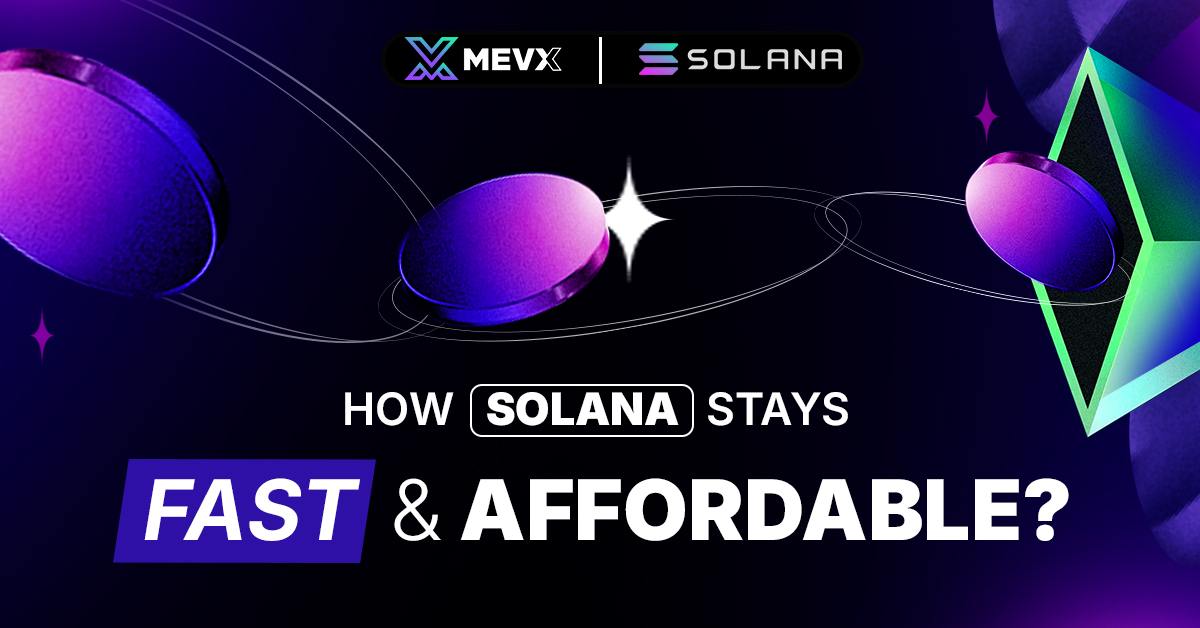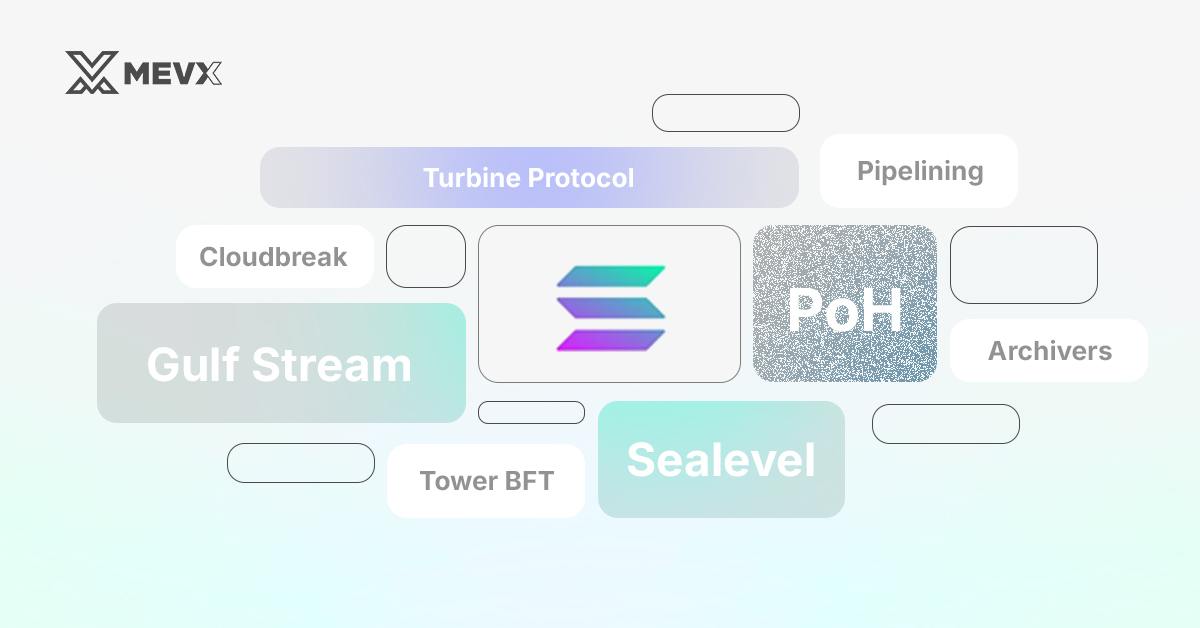Solana has been one of the most hyped blockchains because of its impressive transaction times and very low costs. It has overcome many scaling issues that most other blockchains have to deal with. So, what makes the Solana blockchain much faster and cheaper than competitors like Ethereum and Bitcoin? In this post, we look at some of the Solana innovations and how they work together to achieve such incredible transaction times and low costs.

How Solana stays fast and affordable
Key Takeaways
- Eight key innovations drive Solana’s performance: Proof of History, Tower BFT, Turbine, Gulf Stream, Sealevel, Pipelining, Cloudbreak, and Archives.
- PoS and PoH eventually create a better balance between security and scalability.
- Solana supports up to 65,000 transactions per second (TPS) with minimal fees.
- Solana can provide optimal functionality to support decentralized applications (dApps), DeFi applications, and NFTs.
1. Proof of History (PoH)
The reason behind this high throughput at low latency lies in the way Solana implements its consensus mechanism: Proof of History. PoH is a kind of cryptographic clock that timestamps transactions prior to them being processed by the network, allowing those transactions to be pre-ordered instead of an extensive number of communications between nodes to agree on some sequence. This greatly improves the speed at which those transactions are confirmed.
By decoupling the time to achieve consensus from processing a transaction, PoH lets Solana process transactions in parallel, which gives Solana much greater efficiency relative to traditional blockchains.
Proof of Stake (PoS) and Proof of History (PoH)
The combination of Proof of Stake (PoS) and Proof of History (PoH) is at the core of Solana’s high-speed and low-cost performance.
- Proof of Stake (PoS): Solana uses the PoS consensus algorithm to secure the network, allowing validators to stake their SOL tokens and participate in the consensus process. This model consumes much less energy compared to the Proof of Work (PoW) mechanisms of Bitcoin, and simultaneously, a secure and decentralized method is provided to validate all the transactions that pass on.
- Proof of History (PoH): PoH is considered the most important innovation of Solana, meant to eliminate the need for nodes to gossip with one another to decide upon the time and order of transactions. Instead, PoH creates a cryptographic timestamp for each transaction such that parallel processing of the transactions is possible, independent of traditional consensus. PoH preorders the set of transactions in such a way that there is significantly higher throughput for the network.
That is to say, the combination of PoS for security and PoH for ordering transactions gives Solana the capability to process transactions in the blink of an eye while maintaining decentralization.
2. Tower BFT
Solana uses an optimized consensus algorithm called Tower BFT, which is based on an adaptation of Practical Byzantine Fault Tolerance (PBFT), further enhanced with Proof of History (POH).
- Validators could reach consensus faster when referencing PoH timestamps with minimal communication across nodes.
- This drastically reduces the communication overhead and is therefore speeding up transaction finalization.
- It reduces the time and resources wasted to achieve network-wide consensus through the streamlined consensus mechanism.
Because of this, Tower BFT enables Solana to sustain high transaction performance even in conditions of high load, which means extensive volumes of transactions are processed with virtually no delay by the network.
3. Turbine Protocol for Data Propagation
Solana furthers this performance optimization with a protocol called Turbine Protocol, designed for efficiently propagating data over the network. As such, instead of relaying entire blocks of data across all nodes, Turbine breaks the information into small packets and sends them parallel across the network.
- It drastically reduces the bandwidth and processing requirements, enabling Solana to achieve faster finalization of transactions without congestion in the network.
- By dividing data into smaller chunks, Turbine enables nodes to process data faster, and scalability increases with the size of the network.
Data, in effect, propagates much faster, and blockchains are faced with much less congestion. This is how Solana can handle thousands of transactions per second.
4. Sealevel
Solana’s approach to smart contracts is also optimized for speed and efficiency through its Sealevel runtime.
- Sealevel allows many smart contracts to execute in parallel, unlike most other blockchain systems. Consider Ethereum: it runs smart contracts consecutively, one after another.
- With Sealevel, Solana can process more than one smart contract at any given time. That increases the throughput, allowing transaction fees to remain very low, even on hectic networks.
This parallel execution capability is especially valuable for many decentralized applications (dApps) and DeFi protocols, where many events occur simultaneously.

Solana’s Innovations
5. Gulf Stream
Another key innovation is Gulf Stream, which allows Solana to eliminate the “mempool”, which is an area where unconfirmed transactions wait in most blockchains.
- Instead of queuing transactions, Gulf Stream pushes transactions directly to validators ahead of time so they’re prepared to go immediately after the previous transaction has been completed.
- This allows Solana to drastically reduce the confirmation time for a transaction and ensures the network will be able to handle a large volume of transactions without facing delays.
- This makes it possible to process as many as 65,000 transactions per second.
By skipping the traditional mempool system, Solana massively reduces network congestion and boosts speed and cost efficiency.
6. Pipelining
Solana uses Pipelining, a special type of transaction processing unit, in optimizing transaction validation.
- This allows for parallel executions at different stages of transaction processing, such as data fetching and signature verification.
- The parallelization speeds up the completion of the transactions, thus yielding a higher throughput.
- Pipelining optimizes transaction validation in such a way that Solana would process a great number of transactions without delays or bottlenecks.
The result is a system that can sustain high-speed, low-cost transactions, even during intensive conditions of the network.
7. Cloudbreak
Cloudbreak is an extremely horizontally scalable accounts database for Solana.
- Cloudbreak organizes account data in such a way as to perform fast reads and writes of a transaction.
- It grants the ability for the network to scale without performance losses.
- This scalability allows Solana to process thousands of transactions simultaneously and helps keep the fee low even when there is strong demand.
Cloudbreak is one of those factors that enable Solana to handle a large number of transactions without compromising on the cost of operations.
8. Archivers
The distributed ledger store in Solana is obtained through the use of Archivers.
- The archiver stores ledger storage across a set of decentralized nodes, ensuring data integrity such that not all nodes need to store the full ledger.
- These nodes efficiently compress and store historical data.
- Archivers keep the Solana ledger lightweight and scalable, supporting its network of low costs.
Cloudbreak is the core component that enables Solana to support high transaction throughput with no increases in operational cost, allowing speed and affordability as the network scales.
Conclusion
The ability of Solana to achieve high speeds at extremely low fees is a consequence of several pioneering innovations working together in concert. Through the use of a consensus algorithm, Proof of Stake, and its specific history-proof mechanisms, supplemented by other technologies like Turbine, Sealevel, and Gulf Stream, the blockchain Solana can process an incredible quantity of transactions with minimal cost. It is, therefore, one of the most efficient and scalable blockchains available at the moment. In this way, once Solana further develops its blockchain technology, the platform will be used for leading platforms like decentralized applications, DeFi, and NFTs, allowing developers and users to realize an efficient and cost-effective solution.
Share on Social Media:
